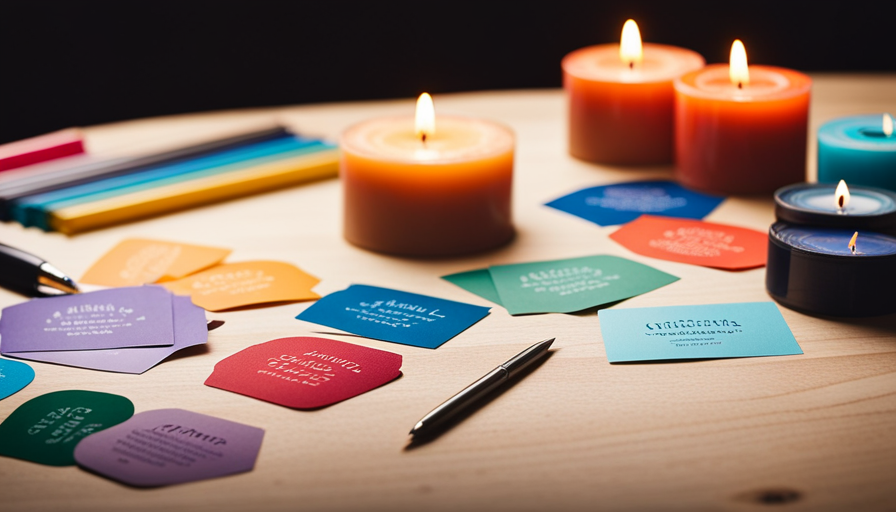Pouring candle wax is like conducting a symphony. Similar to how a conductor carefully leads every note and instrument, the exact temperature at which the wax is poured is crucial in creating beautiful candles. It is essential for achieving a flawless surface, improving the distribution of fragrance, and ensuring a longer burn time.
In this article, I will delve into the fascinating science behind melting points and explain why temperature control is of utmost importance when working with candle wax. I will guide you through the ideal temperature for pouring your wax, sharing techniques that will help you achieve stunning results every time.
But what if things go awry? Don’t worry, I’ve got you covered. I will provide troubleshooting tips to tackle common issues that may arise during the candle-making process.
Safety is paramount, and I will also outline important precautions for working with hot wax to ensure a secure and enjoyable experience.
So, join me as we explore the world of candle making, where precision and experimentation come together to create truly magnificent candles.
Let’s get started!
Key Takeaways
- The ideal pouring temperature for candle wax depends on the type of wax, fragrance load, container size, and ambient temperature.
- Soy wax is recommended to be poured at a lower temperature (125 to 135 degrees Fahrenheit), while paraffin wax is best poured at a slightly higher temperature (145 to 155 degrees Fahrenheit).
- Slow cooling is important for achieving smooth and even candles, preserving fragrance, reducing frosting, and promoting an even burn.
- Layering technique allows for unique designs in candles by adding different colored layers of wax, creating multiple colors and textures.
The Science Behind Melting Points
Now, let’s dive into the fascinating world of melting points and discover the scientific wonders behind them. When it comes to candle making, understanding the science of heat transfer and the melting points of different candle waxes is crucial.
The melting point refers to the temperature at which a solid substance transitions into a liquid state. Each type of candle wax has its own unique melting point, which determines the ideal temperature for pouring.
For example, paraffin wax, one of the most commonly used candle waxes, has a melting point between 120°F and 160°F. Soy wax, on the other hand, has a lower melting point of around 110°F to 130°F. Beeswax, known for its natural and aromatic properties, has a higher melting point of about 145°F to 150°F.
These melting points are important because if the wax is heated too much or too little, it can affect the quality and performance of the finished candle. Understanding the science behind melting points allows us to achieve the desired consistency and appearance of the candle. It ensures that the wax is in its optimal state to hold fragrance oils and dyes properly. Moreover, it helps prevent issues like uneven burning and poor scent throw.
So, now that we have delved into the fascinating world of melting points, let’s move on to the importance of temperature control in candle making.
Importance of Temperature Control
When it comes to making candles, temperature control is of utmost importance for ensuring the quality of the final product. The temperature at which you pour the wax can impact the appearance, texture, and even the scent throw of the candle.
To maintain a consistent temperature during the pouring process, I recommend using a reliable thermometer, keeping a close eye on the temperature of the wax, and making any necessary adjustments to ensure optimal results.
How temperature affects the quality of candles
As the temperature rises or falls, the quality of candles fluctuates like a delicate dance between flickering flames. The temperature plays a crucial role in determining the outcome of the melting process and the appearance of the final candle.
When the wax is melted at a higher temperature, it becomes more fluid and easier to work with. This results in a smoother and more even distribution of color and fragrance throughout the candle. On the other hand, pouring the wax at a lower temperature can lead to a grainy texture and uneven distribution of additives.
To ensure the best quality candles, it’s important to maintain a consistent temperature during the pouring process. This can be achieved by using a thermometer to monitor the wax temperature and adjusting the heat source accordingly. By carefully controlling the temperature, you can create beautiful candles with a professional finish.
Tips for maintaining consistent temperature during the pouring process
To maintain a consistent temperature while pouring, you’ll want to keep a close eye on the thermometer and adjust the heat source accordingly. This is crucial for achieving smooth candles that burn evenly and have a professional finish. Here are some tips to help you maintain a consistent temperature throughout the pouring process:
| Tips for Maintaining Consistent Temperature |
|---|
| Preheat your containers before pouring to prevent temperature fluctuations. |
| Use a double boiler or a heat-resistant container in a water bath to melt the wax. |
| Stir the wax gently and consistently to distribute the heat evenly. |
| Monitor the temperature closely and make small adjustments to the heat source as needed. |
| Avoid pouring the wax when it’s too hot or too cold, as this can affect the quality of the candles. |
By following these tips, you can ensure that your candle wax remains at the ideal temperature for pouring, which we’ll discuss in the next section about achieving the perfect candle.
Ideal Temperature for Pouring Candle Wax
When it comes to pouring candle wax, it’s crucial to consider the recommended temperatures for different types of wax. Each type of wax has its own ideal pouring temperature. This temperature can greatly affect the quality and performance of the final candle. Factors such as the type of wax, the desired fragrance load, and the container size should all be taken into account when determining the ideal pouring temperature. It’s important to be knowledgeable and precise in order to achieve the best results.
Recommended temperatures for different types of wax
For optimal results, you should ensure that you pour candle wax at the recommended temperatures based on the type of wax you’re using.
Different types of wax have different melting points, which means they require different pouring temperatures for the best results.
For example, soy wax has a lower melting point compared to paraffin wax, so it’s recommended to pour soy wax at a lower temperature, around 125 to 135 degrees Fahrenheit.
On the other hand, paraffin wax has a higher melting point, so it’s best to pour it at a slightly higher temperature, around 145 to 155 degrees Fahrenheit.
Temperature control is crucial when pouring candle wax as it affects the appearance and performance of the final product. It ensures proper adhesion, smoothness, and evenness of the wax.
Factors to consider when determining the ideal pouring temperature include the type of wax, container size, and desired finish.
Factors to consider when determining the ideal pouring temperature
When it comes to pouring candle wax, it’s crucial to consider the ideal pouring temperature. This temperature plays a significant role in ensuring the success of your candle-making process.
Several factors should be taken into account when determining the ideal pouring temperature.
-
Wax Type: Different types of wax require different pouring temperatures. For example, soy wax typically has a lower pouring temperature compared to paraffin wax.
-
Fragrance and Additives: If you’re adding fragrance oils or other additives to your wax, it’s important to consider their specific melting points and adjust your pouring temperature accordingly.
-
Container Material: The material of the container you’re using can affect the cooling rate of the wax. For instance, glass containers retain heat longer than metal containers.
-
Ambient Temperature: The temperature of your surroundings can impact the cooling process. It’s essential to pour your wax in a controlled environment to ensure optimal results.
By carefully considering these factors, you can achieve the ideal pouring temperature for your specific candle-making project. Now, let’s explore techniques for achieving beautiful candles.
Techniques for Achieving Beautiful Candles
When it comes to achieving beautiful candles, there are a few techniques that I find particularly effective. First, using the slow cooling method ensures that the candles cool evenly, resulting in a smooth and flawless appearance.
Additionally, the layering technique allows for the creation of unique designs by adding different colored layers of wax to the candle.
These techniques, when implemented properly, can truly elevate the aesthetic appeal of your candles.
Slow cooling method for smooth and even candles
To achieve perfectly smooth and even candles, you’ll want to let the wax cool slowly, like a gentle breeze caressing a calm summer evening. Slow cooling is essential for ensuring that the candle burns evenly and avoids any unsightly uneven surfaces or air pockets. Here are five key reasons why the slow cooling method is crucial for creating beautiful candles:
-
Preserves the fragrance: By allowing the wax to cool slowly, the fragrance oils have ample time to bond with the wax, resulting in a more potent and long-lasting scent.
-
Prevents cracking: Rapid cooling can cause the wax to contract and crack, whereas slow cooling promotes a smooth and flawless appearance.
-
Enhances color vibrancy: Slow cooling allows the pigments in the wax to fully disperse, resulting in rich and vibrant colors.
-
Minimizes frosting: Frosting, a common issue in candle making, is reduced when the wax cools slowly and evenly.
-
Promotes an even burn: Slow cooling ensures that the candle burns uniformly, maximizing its lifespan and providing a consistent flame.
Now, let’s move on to explore the layering technique for creating unique designs.
Layering technique for creating unique designs
Try experimenting with the layering technique to create one-of-a-kind designs for your candles. Layering techniques allow you to add multiple colors and textures to your candles, resulting in unique and eye-catching designs.
To start, melt your first layer of wax and pour it into the candle mold, making sure to leave some space for additional layers. Once the first layer has cooled and solidified, melt your second layer of wax in a different color or fragrance and carefully pour it over the first layer.
You can repeat this process with as many layers as you desire, experimenting with different colors and patterns to achieve your desired design. The layering technique is a great way to get creative with your candles and make them truly stand out.
Now, let’s move on to troubleshooting common issues when making candles.
Troubleshooting Common Issues
One common issue in candle making is that the wax may not melt evenly if the temperature is too low. To troubleshoot this issue and enhance fragrance throw, there are a few things you can try:
-
Increase the temperature: If you notice that the wax isn’t melting evenly, try increasing the temperature slightly. This will help ensure that the wax melts completely and evenly, allowing for better fragrance distribution.
-
Stir the wax: Another common issue is that the fragrance oil may not be mixing well with the wax. To solve this problem, try stirring the wax and fragrance oil mixture more thoroughly. This will help distribute the fragrance evenly throughout the wax, resulting in a stronger scent throw.
-
Use a different container: Sometimes, the issue may lie with the container you’re using. Certain containers may retain heat more effectively, leading to more even melting of the wax. Consider trying different types of containers to see if this improves the melting process.
By troubleshooting common issues like uneven melting and enhancing fragrance throw, you can create high-quality candles.
In the next section, we’ll discuss the tools and equipment you can use to control the temperature more effectively.
Tools and Equipment for Temperature Control
When it comes to temperature control in candle making, there are two essential tools and equipment that are necessary for accurate and controlled heating.
First, a thermometer is crucial for measuring the temperature of the wax precisely. This ensures that the wax is heated to the correct temperature for pouring.
Additionally, using a double boiler or a melting pot provides a safe and controlled method of heating the wax, as it helps to prevent direct heat contact and potential overheating.
Thermometers for accurate temperature measurement
To get the most accurate temperature measurement, you should definitely use a thermometer when pouring candle wax. Thermometer accuracy is crucial in achieving the desired consistency and quality of your candles. Without a thermometer, you may encounter temperature variations that can lead to problems such as uneven melting, poor fragrance throw, or even candle cracking.
To help you understand the importance of thermometer accuracy, let’s take a look at the following table:
| Temperature (°F) | Candle Result |
|---|---|
| Below 120 | Wax won’t melt properly |
| 120-140 | Wax melts unevenly |
| 140-160 | Ideal pouring temperature |
| Above 160 | Wax may crack or create air bubbles |
Using a thermometer ensures that you maintain the ideal pouring temperature, resulting in beautiful, well-formed candles. Now, let’s move on to the next section about using a double boiler or melting pot for safe and controlled heating.
Double boiler or melting pot for safe and controlled heating
Using a double boiler or melting pot provides a safe and controlled method for heating your wax. These melting techniques ensure that the wax is heated evenly and prevents it from coming into direct contact with a heat source, which could lead to overheating and potential hazards.
A double boiler consists of two pots, with the smaller pot placed inside the larger one. The larger pot is filled with water, while the smaller pot holds the wax. This indirect heat source gently and gradually melts the wax, preventing any sudden temperature changes.
A melting pot, on the other hand, is specifically designed for melting wax and often comes with a built-in temperature control feature. These tools allow for precise temperature control, ensuring that the wax reaches the desired melting point without overheating.
By using a double boiler or melting pot, you can safely and effectively heat your wax for candle making.
Moving on to safety precautions for working with hot wax…
Safety Precautions for Working with Hot Wax
When working with hot wax, it’s crucial to follow proper handling techniques to prevent burns. This includes using heat-resistant gloves, aprons, and goggles to protect yourself from any potential splashes or spills.
Additionally, fire safety measures should be implemented when working with open flames, such as keeping a fire extinguisher nearby and ensuring a clear and unobstructed work area.
Proper handling techniques to prevent burns
Make sure you handle the candle wax with care to avoid getting burned, by gently holding the container and slowly pouring it into the mold. To prevent burns, it’s important to follow proper handling techniques.
First, always wear protective gloves to shield your hands from hot wax.
Secondly, make sure to pour the wax in a controlled manner, avoiding any splashes or spills. Keep a safe distance from the hot wax and never rush the pouring process.
Additionally, be cautious of any hot surfaces or objects nearby that could potentially cause burns.
Lastly, never leave hot wax unattended or within reach of children or pets.
By following these burn prevention and handling techniques, you can ensure a safe and enjoyable candle making experience.
Now, let’s discuss fire safety measures when working with open flames.
Fire safety measures when working with open flames
To ensure a delightful experience, it’s crucial to prioritize fire safety precautions when working with open flames. Fire prevention and emergency preparedness should be at the forefront of our minds to minimize any potential risks.
Here are four essential measures to consider:
-
Keep a fire extinguisher nearby: Having a fire extinguisher within reach can help quickly extinguish small flames before they escalate into a larger fire.
-
Clear the surrounding area: Ensure that the workspace is free from any flammable materials or objects that could catch fire easily.
-
Never leave flames unattended: It’s essential to stay vigilant and never leave an open flame, such as a candle, unattended. Always extinguish it before leaving the room.
-
Familiarize yourself with emergency procedures: Be aware of the location of fire exits and have a plan in place in case of an emergency.
By following these fire safety measures, you can confidently proceed to the subsequent section about testing and experimentation, where we explore different techniques for pouring candle wax.
Testing and Experimentation
Experiment with different temperatures when pouring candle wax to find the sweet spot that will create the perfect burn. Testing methods play a crucial role in determining the optimal temperature for pouring candle wax. By varying the temperature, we can observe the impact it has on fragrance release, which is an essential aspect of candle making. To illustrate this, let’s take a look at the following table:
| Temperature (°F) | Fragrance Release |
|---|---|
| 130 | Low |
| 150 | Moderate |
| 170 | High |
| 190 | Low |
| 210 | Moderate |
As we can see, the temperature directly affects the fragrance release. The optimal temperature may vary depending on the specific fragrance used, so it is essential to conduct experiments to find the perfect balance. By doing so, we ensure that our candles emit a pleasing aroma when burned.
Now, let’s move on to the next section, where we will explore enhancing candle performance with additives. Understanding temperature’s impact on fragrance release is just one step towards creating the best possible candle.
Enhancing Candle Performance with Additives
After conducting extensive testing and experimentation on candle wax pouring temperature, I’m now excited to delve into the fascinating world of enhancing candle performance with additives. Additives can be a game-changer when it comes to creating unique and captivating candles. By incorporating additives for fragrance and color enhancement, you can elevate your candle-making skills to a whole new level.
One of the most popular additives for candles is fragrance oils. These oils come in a wide variety of scents, allowing you to create candles that fill the air with delightful aromas. Whether you prefer the soothing scent of lavender or the invigorating fragrance of citrus, there’s a fragrance oil that’ll suit your preferences perfectly.
Additionally, additives can be used to enhance the color of your candles. Dyes and pigments can be added to the wax to create vibrant and eye-catching hues. From soft pastels to bold and bright shades, the possibilities are endless.
By incorporating additives for fragrance and color enhancement, you can create candles that not only provide a warm and inviting ambiance but also delight the senses with their captivating scents and stunning colors.
Now, let’s move on to the final section where I’ll share some valuable tips and tricks to ensure your candle-making endeavors are a resounding success.
Final Tips and Tricks
Get ready to take your candle-making skills to the next level with these final tips and tricks that’ll ensure your creations are nothing short of a glowing success!
When it comes to final finishing touches, there are a few key techniques to keep in mind.
-
Dip-Dye: Create a mesmerizing ombre effect by dipping the bottom of your cooled candle into a different colored melted wax. Gradually lift it out to achieve a seamless transition from one color to another.
-
Embeds and Decorative Additions: Add a touch of elegance to your candles by embedding small objects or decorative additives into the wax. Whether it’s dried flowers, seashells, or even glitter, these creative embellishments will make your candles stand out.
-
Carving and Sculpting: Take your candle to the next level by carving intricate designs or sculpting shapes into the hardened wax. This technique requires a steady hand and some practice, but the end result’s worth it!
-
Custom Labels and Packaging: Don’t forget about the presentation! Design custom labels and package your candles in unique and eye-catching ways. From personalized tags to beautifully decorated boxes, the packaging adds an extra touch of professionalism to your finished product.
With these final tips and tricks, you’ll be able to add those perfect finishing touches and creative embellishments to your candles, making ’em truly one-of-a-kind.
Frequently Asked Questions
How do I determine the melting point of the wax I am using?
To determine the melting point of the wax I’m using, I can employ a method called melting point determination. This involves measuring the temperature at which the wax begins to melt. By gradually increasing the temperature and observing when the wax completely liquefies, I can pinpoint its melting point with precision.
This process is crucial for ensuring the appropriate temperature when pouring candle wax, as it allows for optimal results in terms of appearance and performance.
Can I use a regular kitchen thermometer to measure the temperature of the wax?
Yes, you can definitely use a regular kitchen thermometer to measure the temperature of the wax. It’s important to maintain the correct wax pouring temperature because it ensures that the candle sets properly and burns evenly. Using a kitchen thermometer for wax temperature measurement allows you to accurately monitor the temperature and make any necessary adjustments. This precision is crucial for achieving the desired results and creating high-quality candles.
What are some signs that the wax is too hot to pour?
Warning signs and safety precautions are important when working with hot candle wax. It’s crucial to be aware of signs that the wax is too hot to pour.
Look out for bubbling or smoking wax, as it indicates overheating. Additionally, if the wax starts to emit a strong odor or change color, it’s a clear sign that it’s too hot.
Always prioritize safety by using a thermometer and following proper guidelines to prevent accidents and burns.
Are there any specific techniques for achieving different candle shapes or designs?
To achieve different candle shapes or designs, there are various creative candle making techniques and different candle molds that can be used. These molds come in a wide range of shapes and sizes, allowing for endless possibilities in candle design.
By carefully pouring the wax into these molds and allowing it to cool and solidify, unique and intricate candle shapes can be achieved. Experimentation and attention to detail are key in mastering this art form.
Can I add fragrance or color to the wax while it is still hot?
Absolutely! You can add fragrance or color to the wax while it’s still hot. Adding fragrance to candle wax after pouring is a popular technique. To achieve this, I recommend using fragrance oils specifically designed for candle making. Once the wax has cooled and hardened slightly, but is still warm and pliable, you can add a few drops of the fragrance oil. Gently stir the wax to distribute the fragrance evenly.
As for coloring, using natural dyes is a fantastic option. They can be added to the melted wax before pouring, ensuring a beautifully colored and scented candle.
Conclusion
In conclusion, mastering the art of pouring candle wax requires precision and attention to detail. By understanding the science behind melting points and controlling temperature, we can achieve beautiful candles that burn evenly and efficiently.
Like a skilled sculptor molding clay, we can mold our wax into stunning creations that fill our homes with warmth and fragrance. With the right techniques, troubleshooting skills, and safety precautions, we can explore the endless possibilities of candle making.
So, let your creativity ignite and let your candles shine like a constellation in the night sky.
















